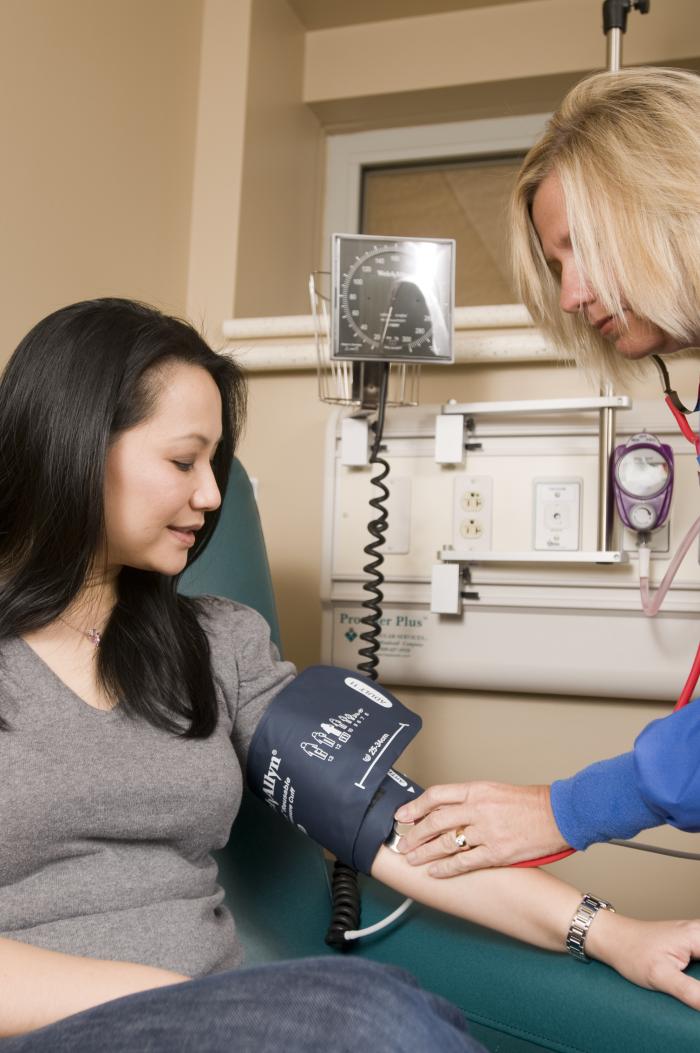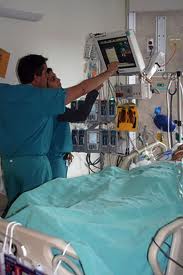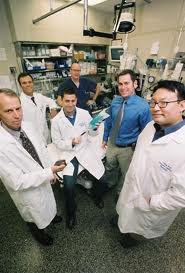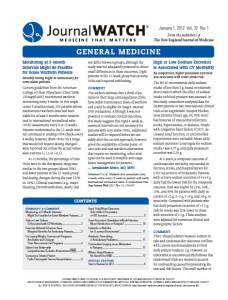August 19th, 2013
Managing Hypertension – Not as Easy as It Once Seemed
Paul Bergl, M.D.

Target a blood pressure < 140/90 mmHg in everyone, but be rational in the medications you choose to get there.
Hypertension…
As a medical student, I never really understood the fuss over it. Practicioners had an excellent and concise guide in the JNC-7 to handle all of the major aspects of this disease. The JNC-7 guidelines were algorithmic, and a helpful table of compelling indications for antihypertensive agents couldn’t make life any easier.
I soon realized a little more finesse was required of the internist-in-training. JNC-7 didn’t tell the whole story. My attendings all had slightly different opinions on the optimal strategies for control, and these approaches might contradict my antihypertensive gospel.
Hydrochlorothiazide was replaced by chlorthalidone after a preceptor noted, “All of the important studies on thiazides were done with chlorthalidone.” After adopting its use, I found another internist who advised, “Chlorthalidone just causes more hypokalemia. There’s no reason to believe HCTZ is inferior.” So, back to HCTZ. Soon after, I learned that calcium-channel blockers were a preferred option for isolated systolic hypertension in elders. “Diuretics just make older patients dizzy, dehydrated, and hyponatremic.” And the advice continued to accumulate in the form of these little pearls.
To complicate matters further, various societies and expert-written guidelines also had a slightly different take on the ideal systolic and diastolic pressures. I was becoming dizzy myself. Do I target a systolic blood pressure of 130 mm Hg in patients with diabetes? Or was that patients with CKD? Or is the diastolic blood pressure more important? And does it really matter?
Well, if JNC-8 looks anything like the Eurpoean Society of Hypertension/European Society of Cardiology joint guidelines that are so nicely summarized in Joanne Foody’s NEJM Journal Watch article, we can all breathe a sigh of relief. As Dr. Foody highlights, these guidelines emphasize a more universal blood pressure target of 140/90 mm Hg and a greater focus on global cardiovascular risk. I haven’t gotten through the whole document, but I was also glad that these guidelines allow for more lenient control in elders. And these guidelines are not at all prescriptive in the choice of antihypertensive medications.
A brief report in Physician’s First Watch on a common class of antihypertenisves also caught my eye this past week. Staff writer Amy Orciari Herman reported on the recent JAMA Internal Medicine article by Christopher Li et al showing an association between long-standing calcium channel blocker (CCB) use and risk for breast cancer.
The article gave me pause for one major reason: I really fell in love with CCB’s as a house officer. CCB’s struck me as an affordable, convenient, and efficacious antihypertensive class. Amlodipine in particular seemed to promise worry-free prescribing to this young physician. Patients liked the once-daily dosing and small pill size. Since amlodipine required no periodic electrolyte checks and side effects are uncommon, I would gladly discharge a patient from the hospital on it. If the patient was lost to follow-up, I probably wouldn’t be on the hook for an adverse drug effect.
Or maybe I will be. This population cohort study suggests an elevated risk of breast cancer with CCB’s. While this study doesn’t prove causality, it should make us all a little more circumspect about the antihypertensives we choose.
In the end, these articles gave me a chance to reflect on what we ought to teach residents about managing hypertension. I expect I will keep my teaching simple in the coming years:
- Go for 140/90 in everyone; be a little more lax in those with advanced age.
- Make sure your choice of an antihypertensive is rational.
- Every drug has side effects and risk; make sure your choice to treat hypertension is rational.
August 13th, 2013
Broad Is Best? The Culture and Etiquette of Antibiotic Selection in the Training Environment
Paul Bergl, M.D.
Friends and colleagues, welcome to the new academic year! I am delighted to be a chief resident blogger for NEJM Journal Watch for the coming year. Without further ado, let’s discuss residents’ use of antibiotics.
Antibiotic selection can either be one of the most anguishing or most mindless decisions that an internal medicine resident makes. For some patients, defaulting to a broad spectrum makes sense. A patient with neutropenic fever who is in shock deserves stat delivery and subsequent administration of almost every antibiotic in the pharmacy — at least until culture data can guide more informed decisions.
On the other hand, some patients require a little more deliberation in nuance. Most residents have probably dealt with some degree of self-torment in choosing antibiotics.
- Is this really a community-acquired infection? A true community dweller is hard to find these days, and didn’t I just read something about infections like MRSA and C. difficile making their way out into the community?
- Is this antibiotic regimen really the correct spectrum? I know my Sanford guide says so, but this patient just looks too sick to use a narrower spectrum. Maybe I’ll broaden just so I don’t miss something, and I’ll let my attending decide when to narrow.
- I know not all fevers are from infection, but how can I justify withholding antibiotics on rounds tomorrow? What if my patient ends up in the ICU because I didn’t start antibiotics?
- The pharmacy says the antibiotic I want to use is restricted for use by the Infectious Disease consultants only. But my patient needs this antibiotic… Besides, the most critical thing I can do for a septic patient is give them broad-spectrum antibiotics as quickly as humanly possible, right?
A recent NEJM Journal Watch article broaches these topics and offers a little solace to the conscientious and excessively deliberative house officer.
Abigail Zuger reviewed an article by Charani et al in Clinical Infectious Diseases that evaluated prescribing practices in four London hospitals. The authors interviewed nurses, pharmacists, and physicians and identified that a “prescribing etiquette” is woven into the culture of medicine. There were several aspects to this culture that we’ve all likely experienced:
- Colleagues do not want to question another’s autonomy. For example, a pharmacist might defer to a senior attending’s antibiotic selection even if the pharmacist perceives it as irrational.
- Everyone tolerates noncompliance with policies. Thus, even though a stewardship plan is in place, stewards might be lenient with policies and might not offer much of a hindrance to poor prescribing practices.
- Even though trainees write most of the orders for antibiotics, the approach to antibiotic therapy is gleaned from attendings and consultants. A hospital might have prescribing policies, but trainees are more likely to be influenced by the patterns of other prescribers instead.
This culture probably makes the resident more vulnerable as well. If the antimicrobial stewards are unable to regularly enforce their policies, then the resident has even less leverage. Given this culture and the uncertainty in our own knowledge and skills, who can blame a house officer for the “broad is best” and “more antibiotics are better than less” approaches?
I look forward to your comments.
August 2nd, 2013
A Time of Transition
Jonathan Schwartz
 August is here, and we are deep in the throes of a new academic year. With this annual cycle, we deal with transitions in the academic medical world – many of which seem somewhat painful at first glance but, on closer inspection, actually can be quite fun. Many of you in medical training undoubtedly have moved into new roles: be it matriculation from student to intern, or adjusting to the care manager and team leader simultaneous roles with the switch from intern to resident. The transition from junior resident to senior resident typically is less dramatic, but generally means more time for self-directed learning and a focus on the next steps in your career. Arguably, the most unnerving transition is that from senior resident to independent practitioner. That said, a great number of NEJM Journal Watch readers have likely opted to continue training and begin fellowship (the category to which I belong!).
August is here, and we are deep in the throes of a new academic year. With this annual cycle, we deal with transitions in the academic medical world – many of which seem somewhat painful at first glance but, on closer inspection, actually can be quite fun. Many of you in medical training undoubtedly have moved into new roles: be it matriculation from student to intern, or adjusting to the care manager and team leader simultaneous roles with the switch from intern to resident. The transition from junior resident to senior resident typically is less dramatic, but generally means more time for self-directed learning and a focus on the next steps in your career. Arguably, the most unnerving transition is that from senior resident to independent practitioner. That said, a great number of NEJM Journal Watch readers have likely opted to continue training and begin fellowship (the category to which I belong!).
A few researchers have looked into whether this abrupt transition each academic year has an effect on patient care. Dubbed the “July effect,” studies have shown some evidence of decreased quality of healthcare in July (with careful attention to how quality is defined). A meta-analysis of such studies was published in the Annals of Internal Medicine in 2011 (see the NEJM Journal Watch summary here), which reported higher patient mortality, as well as lower hospital efficiency during this trainee transition period. However, the evidence is not strong, and further inspection with high-quality studies is needed. I would argue that, in fact, new trainees have an intense focus and are highly motivated to do an excellent job – particularly when starting at a new position. Combining this with attending physicians who take a more hands-on approach to guiding their trainees so early in their careers, I believe a strong argument can be made that patients receive better, if not equal, care in July as in other months. Regardless, attentiveness to detail and a low threshold for seeking help when needed is prudent, particularly during these first few months.
The new academic year has also brought my own transition to fellowship training; it has been an incredibly exciting progression (and sometimes scary!) to now call myself a cardiology fellow. This transition has provided me with new motivation to understand and master new skills, this time not only to increase my knowledge base with specific focus on cardiovascular medicine, but also to prepare for eventual independent practice as a cardiologist. The transition from chief resident to first-year fellow has been quite humbling at times, but I clearly remember the transition from medical student to intern just a few years ago – it’s not significantly different!
As you might have guessed, this new role for me also means the time has come to pass the baton of the Journal Watch Chief Resident Blog to a new pair of authors, to whom you’ll be introduced shortly (stay tuned for a new post soon…). I wish each of you the best of luck in your new positions, whatever and wherever they may be!
Kindest regards,
Jonathan Schwartz, MD
May 24th, 2013
The MICU Rotation — Oh, no!
Jonathan Schwartz
 After a well-received post last week that focused on a commonly asked question I have fielded this year, I thought another common question would make for an excellent topic this week. We’ll focus on the MICU rotation from the resident (and, potentially, the medical student) perspective.
After a well-received post last week that focused on a commonly asked question I have fielded this year, I thought another common question would make for an excellent topic this week. We’ll focus on the MICU rotation from the resident (and, potentially, the medical student) perspective.
The MICU can be one of, if not the most, daunting rotations of residency. However, I believe that many students, interns, and residents would agree with this statement: “After I completed that rotation, it ended up being one of the best months in my entire residency.” I say this from a learning perspective, but the MICU rotation can also be a confidence boost. Realizing you can save simultaneous “crashing” patients with entirely separate disease processes can be quite rewarding – even in the unfortunate situations with poor clinical outcomes.
I am of the opinion that the worst part of the MICU rotation is dealing with the unexpected. Not knowing how many admissions will be called during your shift, the uncertainty of just how sick these patients will be, and the insecurities you might have about your own clinical knowledge and/or skills can make for quite an intimidating call day – and potentially an intimidating month.
What can we do to calm these fears? Good solutions are hard to come by (aside from simply diving in head first, and proving to yourself that you are capable). However, before starting your rotation, reviewing a few clinical concepts and manuscripts will likely pay great dividends. Additionally, I have a few pieces of advice that will also make for a much smoother, enjoyable experience in the MICU.
I had a few discussions with my colleagues to identify some of the most important manuscripts to review while working in the intensive care unit. This list is by no means exhaustive, but it serves as a good starting point and a reasonable inventory to at least briefly reconsider (or sometimes consider for the first time, if this is your first ICU experience!) before starting your rotation. With that caveat, here is my list of 7 landmark articles:
- Sepsis – Early Goal Directed Therapy (or read the Journal Watch summary for a capsule view of this landmark paper)
- Therpeutic hypothermia after cardiac arrest and Treating Comatose Survivors of Cardiac Arrest (read the Journal Watch summary)
- Transfusions in the ICU – TRICC trial (read the Journal Watch summary)
- Respiratory failure – ARDSnet and low tidal volume ventilation
- Corticosteroids in septic shock – CORTICUS (read the Journal Watch summary) and a French corticosteroid trial (read the Journal Watch summary)
- Fluid management – FACTT (read the Journal Watch summary)
- Blood glucose control and insulin therapy in the critically ill – NICE-SUGAR trial (read the Journal Watch summary)
Obviously many other topics and manuscripts are as important as those I’ve listed above. But, I’ve found these are very commonly referenced papers, and they’ll serve as an excellent starting point for keeping the doubts and apprehension at bay in the days leading up to the start of your MICU rotation.
How about a few general tips for the MICU month?
- Decipher the schedule and plan for fun activities to do on your days off. You’ll likely be working very hard while at work; recharging while away from the hospital is vital. Also, plan ahead to prevent any scheduling surprises mid-month.
- Do not hesitate to seek help when you are starting to feel uncomfortable. Almost certainly, you will have multiple resources for help if you need it — a co-intern or resident, the patient’s nurse, the pulmonology/critical care fellow, your attending, a pharmacist… You simply have to ask for help!
- Focus on details. You might be able to skip over some pieces of data, vital signs, parts of the physical exam, and other aspects when you are on other rotations, but this practice is both dangerous and sloppy when you are caring for critically ill patients.
Finally, enjoy yourself! Even if you hate critical care, smiling and making the best of a potentially bad situation will take you quite far. Who knows, maybe you’ll even find a new interest you never realized you had — only because you never gave it a chance!
I would love to hear your own ideas on important papers, topics, and general tips for the MICU. Post a comment below!
May 15th, 2013
The Next Step: Fellowship Applications
Jonathan Schwartz
 The end of the academic year is fast-approaching, which means many changes and exciting transitions lie ahead – for all levels of trainees: medical students and new interns, brand-new attending physicians, and seasoned diagnosticians alike. One of the more stressful tasks facing many of the senior residents in the coming months is the fellowship application process. We recently held a program-wide gathering here at the University of Colorado to discuss tips that potentially can ease the process – and possibly even calm the nerves of anxious soon-to-be fellowship applicants. I completed the fellowship match process this past year, and identified a few pointers that would have been helpful to know prior to applying. Here’s my list of 8 tips to get the perfect fellowship:
The end of the academic year is fast-approaching, which means many changes and exciting transitions lie ahead – for all levels of trainees: medical students and new interns, brand-new attending physicians, and seasoned diagnosticians alike. One of the more stressful tasks facing many of the senior residents in the coming months is the fellowship application process. We recently held a program-wide gathering here at the University of Colorado to discuss tips that potentially can ease the process – and possibly even calm the nerves of anxious soon-to-be fellowship applicants. I completed the fellowship match process this past year, and identified a few pointers that would have been helpful to know prior to applying. Here’s my list of 8 tips to get the perfect fellowship:
- Create or update your curriculum vitae. The ERAS fellowship application mirrors the ERAS residency application, so, if you happen to have saved yours from a few years ago, you can use it to speed the data entry. Additionally, investing a substantial amount of time and effort in producing a high-quality personal statement will likely reap great benefits in the form of interview invitations. These two tasks will get your foot in the door… the interview is your time to shine, and stand out from the pack.
- Request letters of recommendation — early! Clearly, you’ll want a letter from your residency program director, as well as your research mentor (if you have completed research). Additionally, I would recommend at least two other letters, ideally from faculty members with whom you have worked closely and who agree to write a strong letter on your behalf. Having letters from faculty in the field to which you are applying is probably best, but not an absolute must – particularly if you have worked a significant amount of time with another mentor that can write a very strong letter. A letter that details your clinical skills as well as personal attributes (and potentially research aptitude) will take you far in the application process, regardless of whether or not the author is in your selected field. It is a fantastic idea to have your letter writers begin working on the letters very soon. When the application officially opens (EFDO tokens will be available on June 12th, 2013), you have approximately 2-4 weeks to complete it before having the option to send it to programs (and I strongly recommend submitting your application to programs as early as possible). Most residency programs have a process that will keep the letters confidential until the application opens; investigate this now, so you will be ready. You also might want to contact your program director to discuss the details of the letter they will be writing on your behalf.
- Focus on creating a list of programs that pique your interest. Many factors must be considered during this process – and these are highly individual. Ideally, you’ll find a handful of programs that: a) are strong in the subspecialty to which you’re applying, b) have mentors and/or research that aligns with your interests, and c) are feasible matches for you.
- Closely review websites for specific programs before submitting your application. Some programs have special requests with regard to your application – topics you need to address in your personal statement, specific requests with regard to letters of recommendation, or other tasks. These guidelines are often used by programs as a first-pass filter (anyone who does not follow the instructions might be quickly rejected; the “shotgun” approach to applications – applying broadly without any knowledge about the program in particular, is not ideal nor recommended). Also, each website provides a wonderful way to learn more about the program. If you have a specific research interest, try to identify a few faculty members whose research potentially align with your interests, and who conceivably could serve as a mentor should you match into their program. Most programs will ask if you would like to meet a particular faculty member during your interview. Having someone in mind demonstrates strong interest.
- Meet with the program director of the subspecialty to which you are applying at your home institution. He or she can help you create your list of programs, and also also might know faculty at programs across the nation to which you are applying. Program directors are potentially a fantastic resource that many applicants do not take advantage of, but definitely should!
- Submit a professional photo with your application if possible, but I do not think this is a requirement. That said, many programs receive countless applications each year (many in excess of 100 times the number of positions available), and if the program is able to put a face with an application, it can help to distinguish you from the rest of the field. A good first impression is a lasting impression – this is not the time for humor!
- Talk to the current fellows in your selected subspecialty at your institution. Not only can they provide specific tips about the application process for your chosen field (each one seems to have a few quirks), but also they are the best resource for overall tips – considering that they just completed the process last year.
- Finally, start saving money (a small fortune might be necessary in some cases!) for the whole process… expenses mount rapidly , especially if you apply to many programs and accept many interviews. Application to 10 programs is included in your the initial fee; beyond this, extra fees will apply (the amount varies depending upon how many programs you ultimately choose).
I hope you have found this list helpful, rather than stress-inducing! I am happy to answer questions – leave a comment below and I will try to reply. Deep breaths, and good luck!
May 8th, 2013
Restart, and a Focus on Vaccinations
Jonathan Schwartz
After a false start, we’re back at it here on the Residency Training blog! From now on, I plan to post most Wednesdays, with some randomly dispersed surprise posts thrown in for good measure. As always, if there’s a specific topic you’d like to see addressed, feel free to make note of it below in the comments section.
That said, let’s get into this week’s topic. I do my best to stay on top of the current medical literature, which I often summarize and pass along to the housestaff and students during the preamble to my daily morning report sessions. While browsing recently, I noticed a theme that appeared in a number of publications: vaccinations.
Unfortunately, vaccinations have been a controversial topic, primarily driven (at least in my opinion) by the lay public and the media. The allopathic and osteopathic medical communities are slowly gaining some ammunition in the argument with the naysayers, and, fortunately, this has come in the form of high-quality data stemming from well-designed trials. I couldn’t be more delighted, as I truly believe vaccinations have been the single greatest medical intervention with the widest impact on humankind.
To touch on a just few of the recent papers centered on vaccinations that caught my eye recently:
- Genital warts in young Australians, 5 years into national human papillomavirus vaccination programme: National surveillance data — The HPV vaccine has caused somewhat of a controversy here in the U.S., as some parents have been reluctant to administer this vaccine to young children. However, this study provides some longitudinal data showing significant benefit just 5 years after a national vaccination program was enacted. It will be interesting to see just what impact the HPV vaccine has on malignancies with significantly longer follow-up. First Watch summarized the data and findings.
- Varicella Death of an Unvaccinated, Previously Healthy Adolescent – Ohio, 2009 — This article serves as an important reminder about “catch-up” vaccinations in our patients. This case was of particular interest to me, as we encounter many unvaccinated patients in our training hospitals. We can easily forget to address this topic in primary care, or simply relegate it to such low priority that we never discuss it — with so many other complaints to address during already-too-short office visits. First Watch also provided a nice summary of this article.
- Effect of an investigational vaccine for preventing Staphylococcus aureus infections after cardiothoracic surgery: A randomized trial — I found this interesting, because as it highlights the often-overlooked risks of vaccinations. This trial (somewhat surprisingly) showed excess postoperative multiorgan failure and death from staphylococcal infections after an investigational vaccine was administered prior to cardiothoracic surgical procedures. It does not establish a causal relation (and, it is interesting to ponder how this would occur, from a pathophysiologic perspective…). That said, in the past, other vaccines have been shown to cause more-severe disease. Journal Watch Infectious Diseases published a nice summary of this article
- Lack of association of Guillain-Barré Syndrome with Vaccinations — After reading the previous article, you may become more diligent about discussing potential side effects of vaccinations with your patients. In this study, researchers examined the longstanding link of Guillain-Barre Syndrome (GBS) with vaccinations (traditionally associated with the annual influenza vaccination). While this is a retrospective study (and hence the evidence is not quite as strong as a randomized, controlled trial), the sheer number of patients included is staggering. The investigators found no causal relation between GBS and any vaccines, and the benefits of vaccination far outweighed the risk of developing GBS.
- The success of the longstanding fight to eradicate polio is nothing short of incredible. Just 223 cases were reported in 2012, with a drastic and steady decline over the past few decades, largely due to an incredible effort to vaccinate at-risk populations in endemic areas. The Scientific Declaration on Polio Eradication outlines specific methods about how this will be achieved. It is a lofty goal, but one that I believe is definitely obtainable. First Watch discusses this statement.
What has been your experience with vaccinations and patients who resist getting them? How have you handled these patient interactions? After looking over these articles, let me know, and we can discuss it!
January 29th, 2013
Dusting Off the Blog: A New Writer Appears!
Jonathan Schwartz
Hello, Journal Watch enthusiasts! It’s a new year, and we are kick-starting the Chief Resident blog again. I am excited to share some of my ideas and thoughts with you this year. I’m currently serving as one of the chief medical residents at the University of Colorado Denver, with the first half of the year spent at Denver Health Medical Center, and the second half of the year at the Denver VA Medical Center.
I grew up in the medical-focused community of Rochester, MN, where the Mayo Clinic Health System dominates the skyline and conversation. I studied Biomedical Engineering as an undergraduate at Northwestern University, with a focus on biotechnology and biomaterials. I returned to the North Star state for medical school, at the University of Minnesota, and opted to venture west to Denver for my Internal Medicine training.
One of the major benefits of the UC Denver IM residency program is the diversity of hospitals and patients encountered on rotations; our core teaching sites include a VA medical center, a major academic institution, a public safety-net hospital, and a private facility. Each of these sites provided a unique view of medicine and a fantastic base upon which to build my interests in cardiovascular disease. I will begin fellowship this summer, and I am anxiously looking forward to it.
During my time as chief resident, I have been fortunate to play many roles: educator, attending physician, colleague, and conflict mediator, among many others. As a Journal Watch blogger, I look forward to sharing some of the things I have learned this year with regard to each of these roles. My particular interests are technology — both as it relates to medical education and to advancing medical care.
I may preferentially favor cardiovascular disease technologies; however, I hope to highlight some of the new and exciting technologies across all fields of internal medicine. I enjoy looking into the balance of introducing new technology with cost, particularly right now, given the Affordable Care Act and its associated mandates. Medical education is a large part of my position as chief resident, and learning about new teaching tools that incorporate novel technologies excites me.
I look forward to sharing my thoughts on current medical literature, and hearing your ideas and responses. Please post some of the topics you hope will be discussed this year, and I’ll look forward to reading your responses!
April 2nd, 2012
What Would You Do?
Gopi Astik, MD
While combing through my social media outlets recently, I came across an article that struck me. The article entitled “Why Doctors Die Differently” addresses a subject many professionals in the medical field know but don’t really talk about — that physicians die too.
 The article explains how we, as physicians, understand the limits of medical therapy and procedures and often forego treatment when the end is near. It’s not that we are ready to die but that we understand the chances of surviving a cardiac arrest with complete neurologic function. We have seen the effects chemotherapy can have on patients and we sometimes think about quality more than quantity of life.
The article explains how we, as physicians, understand the limits of medical therapy and procedures and often forego treatment when the end is near. It’s not that we are ready to die but that we understand the chances of surviving a cardiac arrest with complete neurologic function. We have seen the effects chemotherapy can have on patients and we sometimes think about quality more than quantity of life.
This article presented itself to me at the perfect time. I had a patient who was a 40-year-old female survivor of cervical cancer who was then diagnosed with aggressive cholangiocarcinoma. She was admitted to my service with symptoms of dyspnea and hypoxia caused by a pulmonary embolus that developed because she stopped taking her lovenox. On presentation, she was cachectic, weak, and in obvious respiratory distress. She had recently been told by her oncologist that there were no more treatment options because of the spread of the cancer. The patient never actually spoke during her hospitalization, partly due to her dyspnea and partly because her very supportive and vocal family would not accept that their loved one could not be treated and wanted to try every possible procedure, medication, and therapy.
I had multiple conversations with this patient’s family, but one conversation with her mother will stick with me for the rest of my life. I sat down with the patient and her mother alone after rounds (without residents and students) to provide details about the patients disease and prognosis. I explained that we had no more treatment options to offer and would like to make the transition towards palliative care. When I broached the topic of a DNR, the patient’s mother immediately refused. I tried to reiterate that we weren’t going to be able to treat her daughter and that the cancer would progress to the point where her daughter would not be able to sustain herself on her own. Her mother, who was obviously tired, frustrated, and sad looked me straight in the eye and said “What would you do if you were me?”
I couldn’t answer her question. I was taught never to make such decisions for patients and was told to keep my opinions to myself. I froze for a minute and politely said, “I can’t say what I would do as a family member but as a doctor, this is what I would do.” I know my response didn’t suffice and I felt I had let the patient and her mother down. I know that my perspective as a doctor is very different from that of a nonmedical family member. I also don’t have the life experience to literally put myself in the mother’s shoes.
 I went home that night thinking about this conversation and tried putting myself in the patient’s shoes. If I had terminal cancer, I wouldn’t want my family members to have to make such decisions. If only there was a way for me to plan ahead in case something did happened …
I went home that night thinking about this conversation and tried putting myself in the patient’s shoes. If I had terminal cancer, I wouldn’t want my family members to have to make such decisions. If only there was a way for me to plan ahead in case something did happened …
“ding ding ding”
..the bells in my head went off, the light bulb turned on, and I decided that I had to fill out an advanced directive. I never thought I would fill one of these out at the age of 27, but I know now it’s the right decision. I also have asked my parents to fill out their advanced directives and assign a durable power of attorney for medical decisions.
 I believe the reason so many more physicians than patients prepare these documents and have more perspective at the end of life is because we have seen what happens when people don’t prepare. This case and the article taught me much about my patients, my job as a physician, and mostly about myself. I’d love to hear about some of your thoughts about this topic.
I believe the reason so many more physicians than patients prepare these documents and have more perspective at the end of life is because we have seen what happens when people don’t prepare. This case and the article taught me much about my patients, my job as a physician, and mostly about myself. I’d love to hear about some of your thoughts about this topic.
March 2nd, 2012
Curses and Blessings of Aging
Gopi Astik, MD
It seems that every time I am in clinic, patients bring in supplements they bought to prevent aging. I usually look at the product ingredients, which include vitamins and herbs, and ask myself three questions:
1. Why didn’t I market this? I could put vitamins and herbs together and sell it to the baby boomers saying it prevents wrinkles and Alzheimer’s and make myself a nice chunk of change.
2. Don’t they read the ingredients or ask somebody before spending this money?
3. See #1.
When this happens, I calmly look at the bottle and usually tell patients that the product doesn’t contain any harmful ingredients and advise them that it would be cheaper to take the multivitamin I had already prescribed than spend extra money for this concoction. Everyone is looking for the secret cure to aging that simply doesn’t exist…yet.
A recent summary in Journal Watch General Medicine describes a Mayo clinic study in which senescent cells were marked and destroyed with a compound. When transgenic mice carrying the marker were bred with mice that age prematurely, the animals did not develop age-related disorders and other diseases progressed slowly. Although this technique isn’t being studied in humans yet– and probably won’t help my 87-year-old patient do her “BINGO dance,” — the study paves the way for such research to begin and shows promise for younger folks like me.
On the flip side, another study summarized in Journal Watch alluded to overscreening for cancer in elderly patients. This issue actually came up for me and my medical students this morning. When we looked up guidelines about cancer screening, there were so many different guidelines, it was hard to know which ones to follow.
The patient was a 76-year-old man who had his last colonoscopy at age 65, and a recommendation for 10-year follow up was noted. When comparing guidelines, USPSTF recommends screening for adults aged 50-75, National Cancer Institute recommends screening for adults ages 50-80, and the American Cancer Society recommends screening beginning at age 50 with no upper age limit. With my limited experience and the fear that I could miss something, I erred on the side of caution and told the patient that I would like to screen him again, and he declined. I am probably one of the physicians contributing to overscreening of cancer in elderly patients, but guidelines would be a lot easier to follow if there weren’t so many conflicting ones in the first place.
I also find patients less and less apt to actually have tests done as they get older. A patient today excitedly told us she had earned the right to not have mammograms or pap smears by living to the age of 85. When I asked her about the downside of aging she said, “Honey, I’ll deal with my wrinkles just don’t ever ask me to put my legs in stirrups again.”
February 16th, 2012
What’s New in Medicine
Heidi Zook, MD
Staying up to date with the most recent advances in medicine is a challenge and a necessity if we want to offer patients the best care possible. That being said, being a physician is one of the busiest careers and finding free time to read journals is not exactly easy. That’s where Journal Watch comes into play — it makes this difficult task easier. Following in the footsteps of our predecessor, Dr. Greg Bratton, I’d like to share some recent Journal Watch content that has had an impact on me and potentially the way I practice medicine. Two of the articles are from the Journal Watch General Medicine Year in Review 2011 — a review of the year’s most important thematic areas in clinical research.
To Dr. Bratton — if you are reading, imitation is the sincerest form of flattery!
To our blog readers —which articles had an impact on you? I’d like to know.
For Losing Weight, Commercial Programs Are Better and Cheaper Than Noncommercial Programs — Obesity is an epidemic in our country, and likely one of, if not the, largest consumer of healthcare dollars, yet we have so few tools to help prevent and control this disease. Many of the pharmacologic treatments that have existed in the past have been pulled off of the market. The idea that we could “prescribe” a commercial program might get more of a response than simply counseling on diet and exercise. Joining a commercial program could offer our patients the support, follow-up, and lifestyle coaching that a 20-minute office visit could never offer. That being said, this idea should not deter a physician from continuing to counsel their patients on how to maintain a healthy weight and stay healthy. This is a battle that we will all fight during our careers, just like heart disease and diabetes. The more tools we have, the better.
USPSTF Recommends Against Prostate Cancer Screening — Considering the controversy that developed in 2011 on the subject, I couldn’t resist discussing it as something that impacted my practice. During my interpretation of all of the recommendations that currently exist, I spoke with some of my mentors and more experienced colleagues on the subject. This is undoubtedly a controversial issue. On the one hand, many have experienced diagnosing prostate cancer in a younger man through screening, buying some lucky individuals a significant amount of quality life that they may not have otherwise had. On the other hand, many have seen individuals going through invasive diagnostic and therapeutic measures, with resulting morbidity from the procedures that may not have been necessary in the first place. Add in the potential cost of screening “…the cost to prevent one prostate cancer death through screening would be roughly US$5.2 million” and you end up with a difficult decision. At this point, I discuss the options, risk, and benefits with patients who would be appropriate for prostate screening. I believe that a strong family history as well as any symptoms that might suggest possible prostate cancer in a patient makes the argument on whether or not to screen quite a bit easier.
Atypical Femur Fractures with Bisphosphonates — This was another topic that led to difficult and, for the patient, confusing conversations. It is difficult to convince a patient to take a medication that may cause what it is, in theory, supposed to prevent. I have had discussions with all of my patients who have been on bisphosphonates longer than five years about these recent findings, but I think the following says it all: “Among women with FDA-approved, evidence-based indications for bisphosphonate therapy (i.e., documented osteoporosis or previous osteoporotic fracture), the number of typical hip fractures prevented by bisphosphonate therapy would outnumber the number of atypical femur fractures caused by treatment.” Well said, well said.





